| Main page » Polish armour » armoured cars » Ehrhardt M1917 – Polish artillery – Steel Panthers – what's new |  | ||
| © Michal Derela, 2025 | |||
| Main page » Polish armour » armoured cars » Ehrhardt M1917 – Polish artillery – Steel Panthers – what's new |  | ||
| © Michal Derela, 2025 | |||

One of less typical, but more significant armoured cars in Polish service was a single German world War I era armoured car Ehrhardt M1917, one of only 12 made. It was captured during Greater Poland uprising in 1919 and impressed into service under a name "Pułkownik Kazimierz Grudzielski" (Colonel Kazimierz Grudzielski). It next fought in the 3rd Silesian Uprising under a name "Górny Śląsk – Alzacja". It remained in service after wars until late 1920s.
Note: links in a text without an underline lead to Wikipedia articles.
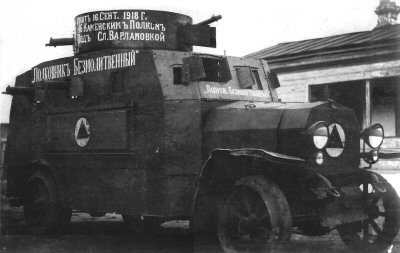 |
| A prototype Ehrhardt M1915 "Polkovnik Bezmolitviennyi" of Don Army (photograph combined from two for the best quality) |
 |
| German Ehrhardt M1917 near Rostov in Russia, 1918 |
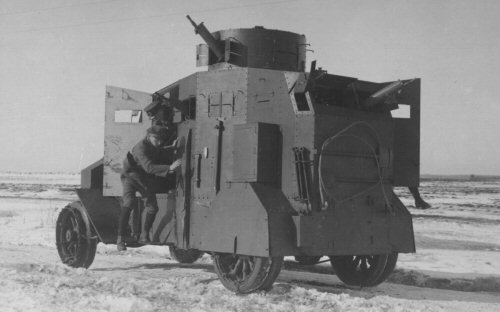 |
| German Ehrhardt M1917 near Dorpat in current Estonia, March 1918 |
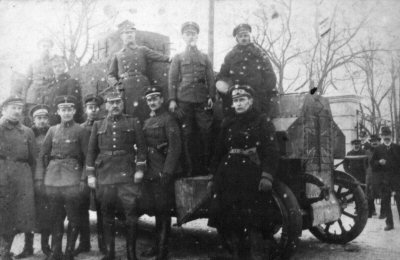 |
| Ehrhardt M1917 soon after its capture by the Polish. Visible is a German cross on a radiator cover. |
 |
| Ehrhardt M1917 "Pułkownik Kazimierz Grudzielski". Visible is number: 838. |
During World War I, especially in its first half, the army of the German Empire did not attach much importance to the development of armored weapons, despite the fact that before the war it had experimentally used several armored cars. Shortly after the outbreak of the war, however, its opponents began to use relatively numerous light armoured cars, primarily built on passenger car chassis, which resulted in a creation of highly mobile vehicles, relatively simple and cheap to build (e.g. the British-Russian Austin). It was not until 22 October 1914 that the German High Command ordered a competition for an armoured car in order to select the best design. It started a long procedure of designing and selecting a vehicle, resulting in the creation of few unique, heavy and expensive vehicles – on the contrary to the allies. As a result, in 1915, three individual prototypes of German armored cars were constructed: Daimler M1915, Büssing A5P and Ehrhardt M1915. All of them were heavy vehicles weighing 9–10 tons, with a crew of 9, armed with machine guns mounted in embrasures in the hull and a fixed turret. Of these, the Ehrhardt M1915 was designed by the Heinrich Ehrhardt company from Thuringia on the chassis of the company's E-V/4 truck. All three vehicles were used in the 1st Armored Car Unit (Panzer-Kraftwagen-Maschinengewehr-Abteilung Nr. 1) fighting in autumn of 1916 in Romania. The Ehrhardt M1915 was later captured by Russian troops, probably later taken over by the Red Army and finally on 16 September 1918 taken over by the white Don Army, where it was named "Polkovnik Bezmolitviennyi" (Colonel Bezmolitviennyi)[3].
The Ehrhardt was considered the best, but it was not until 1917 that the German army ordered 12 series armored cars of an improved model from Ehrhardt, designated as M1917. The armor was modified, including the installation of a cylindrical rotating turret of a smaller diameter. The armor made of Krupp plates was 6-9 mm thick. The vehicle's weight was reduced by almost two tons, to 7.7 ton, thanks to which the speed increased from 38 to 60 km/h. At the same time, four-wheel drive was introduced. It was also distinguished from the prototype by the box-shaped armoured headlight covers on the front fenders with an upper sloping surface, and covered rear fenders with boxes on the upper surface. The cars were equipped with a radio station, with an extendable telescopic antenna, which could be used when stationary. The crew consisted of 8 men. The armament consisted of four or even more 7.92 mm MG 08 Maxim machine guns.
In 1917 another series of 20 cars was ordered, the construction of which was completed only in 1919, after the end of World War I. These cars were designated Erhardt M1919. They differed in a rotating turret with smaller observation hatches and one machine gun embrasure, rectangular headlight covers and a lack of boxes on rear fenders.
In the German Imperial army, Ehrhardt M1917 cars were included in five armored car platoons (Panzekraftwagen-Machinengewehr-Zug) numbered 2 to 6. In 1918 several were sent to the Eastern Front, where after short fighting with the Red Army, leading to the treaty of Brest on 3 March, they performed occupation duties. As can be seen from photographs, they were scattered in the area from Dorpat (Tartu) to Rostov-on-Don. One was captured near Kharkov by Bolshevik troops on 21 May 1918 and later served in the Red Army[3]. A platoon of two Erhardt cars took part in the Germanlanding operation near Poti in Georgia on 25 May 1918, leading to a fighting at Caucasus lasting until September.
After the armistice in World War I, Ehrhardt armored cars remained in the inventory of the still existing German army of the Weimar Republic, and after the Treaty of Versailles – its police forces, supplemented by new M1919 cars.
Among forces sent to suppress the Greater Poland Uprising in 1918/1919, the Germans employed a platoon of M1917 armoured cars under the command of Lieutenant Kurt Amos. This platoon was sent on 7 February 1919 to support an attack on the insurgents' positions from Chodzież to Budzyń. However, the platoon commander's car broke down and Lieutenant Amos embarked the second car of Lieutenant Joachim Graf von Schwerin. Polish positions were defended by a company from Rogoźno. A volunteer infantry section under the command of Senior Rifleman Leon Napiecek set up an ambush on the road north of Budzyń, on Okręglik Hill. After 3 p.m. an approaching armoured car was fired upon by a machine gun, and bullets entering through an open vision hatch killed the driver. The car fell into a ditch on the right side of the road. During the ensuing fight, Lt. Amos and Lt. von Schwerin were killed, among others. Four machine guns, 8,000 rounds of ammunition and as many as 700 grenades were captured with the car. The car was pulled out of the ditch by horses and driven to Budzyń. On 21 February, by order of the commander of the Greater Poland Army, General Józef Dowbor-Muśnicki, it was given the name "Pułkownik Kazimierz Grudzielski", in honor of the commander of the northern sector, Colonel Kazimierz Grudzielski. It was also given the tactical number 838. It was the second known armoured car captured by independent Poland.
The armoured car was assigned to the 10th Greater Poland Rifle Regiment. On 19-20 March it took part in combat near the village of Zamość[1,5]. On the night of 18/19 June the car supported an attack through Rynarzewo towards Bydgoszcz. The commander at the time was 2nd Lt. Kończak. The armoured car, attacking a barricade in front of a bridge, was fired upon by machine guns, whose bullets penetrated the armour and wounded all members of the crew except the commander. However, the driver, Cpl. Józef Nowak, managed to withdraw the car. After the formation of the Greater Poland Front, the car was at the disposal of the front command and temporarily formed part of the 71st motor column, and was then assigned to the 61st Infantry Regiment. In January 1920 it participated in the takeover of the territories granted to Poland by the Treaty of Versailles, stationing in Wyrzysk and then Chodzież. In the spring it was assigned to the 2nd Greater Poland Rifle Division. In August 1920 the car was incorporated into General Sikorski's 5th Army, but its possible use in the Polish-Soviet war is unknown. In September, it became part of the 2nd Armored Car Unit (2 Dywizjon Samochodów Pancernych) in Poznań with registration number 825.
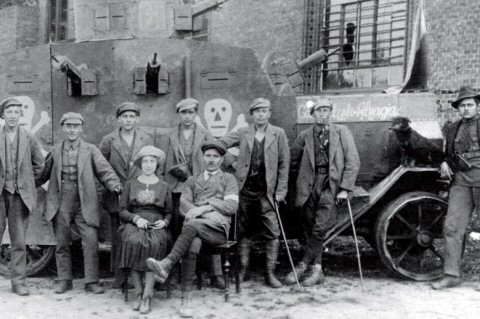 |
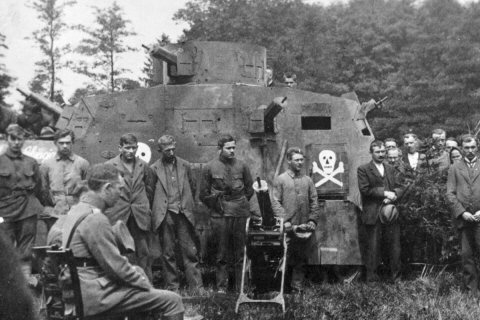 |
|
| Polish Ehrhardt M1917 with the name "Górny Śląsk - Alzacja" during the Third Silesian Uprising. On the right, a fragment of a photo from a field mass. The car might be painted in a camouflage. | ||
After the outbreak of the Third Silesian Uprising, in May 1921, the car was secretly sent to help the insurgents. The German origin of the car probably played a decisive role here, as it did not indicate the involvement of the Polish Army. From among Polish armoured weapons, also some improvised armoured wagons and locomotives were sent to the Upper Silesia. The car commander was a volunteer from Alsace, Cadet A. Forrestier, which is why the car received a painted name: "Górny Śląsk - Alzacja" (Upper Silesia - Alsace). It fought as part of the East Group.
After the end of the Silesian Uprising, the car returned to Poznań. In November 1925 it was sent to Warsaw, where it became part of the 2nd Armoured Car Squadron (2 Szwadron Samochodów Pancernych). At that time, it bore the abbreviated name: "Pułkownik Grudzielski" (Colonel Grudzielski). It was removed from the register in 1928 and most probably scrapped.
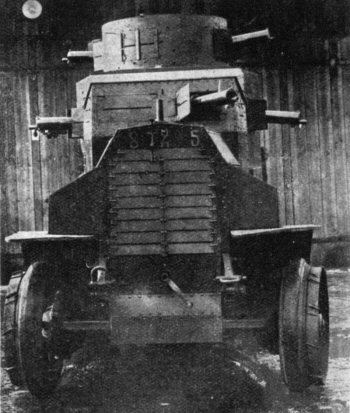 |
| Ehrhardt M1917 "Pułkownik Grudzielski" from the front, during the session as above. |
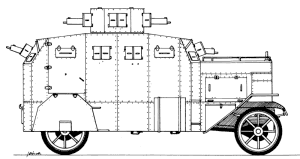 |
| Ehrhardt M1917 [drawing: Adam Jońca] |
The chassis was a modified truck chassis, with a classic rectangular frame. Rigid axles were suspended classically on longitudinal semi-elliptical leaf springs. Front wheels were steered. Spoked, metal wheels with solid rubber tires measured 920 x 140 mm at the front and 1220 x 160 mm at the rear. There were single wheels at the front, with widened rims on the outside improving traction in muddy terrain, and double wheels at the rear.
Drive: Ehrhardt carburetor engine, 4-stroke, 4-cylinder in-line, water-cooled, power: 80 HP at 1200 rpm. Capacity 8490 cm³, cylinder diameter 136 mm, piston stroke 160 mm, compression ratio 1:4[1].
Cone clutch, mechanical gearbox with a reduction gear and reversing mechanism, giving six forward and reverse gears. According to part of sources, both axles were driven (rear by chain). Fuel tank was 190 l.
The body was of a complex shape, made of armour plates, riveted to the frame. The armour thickness at the front and rear was up to 9 mm, on the sides 5-7 mm, on bottom and top 4 mm[1]. Entrance doors were in side walls: on the left at the front and on the right at the rear. In side walls under the turret there were two machine gun embrasures on each side, closed with double-leaf doors. In the front and rear plates there was one embrasure (on the left, from the side of the door) and a driver's observation hatch with a lifting flap (on the right). The car had two driver's positions for driving in both directions. Four smaller observation hatches were in doors and walls opposite to them, and four more small hatches were in corners of the body. The hatches were covered with flaps with observation slots, and there were also slots in embrasure doors. The radiator was protected by an armoured movable shutter. Headlights were in armoured box housings on the fenders with characteristic slanted upper edges.
A cylindrical turret of a large diameter had four machine guns embrasures in the walls on the perimeter, closed with double-leaf doors. The turret was evidently rotating, which is confirmed by analysis of photographs.
The crew was 8 men in German service.
The armament in German service is quoted as 4 7.92 mm Maxim MG 08 heavy machine guns[5]. They could be switched between six embrasures in the hull and four in the turret. According to German publications, in practice it was possible to fire three machine guns at once only due to the limited amount of space. For this reason, the use of the MG 08/15 with a stock (as suggested in some publications) is also doubtful. In Poland, photographs from the mid-1920s show at least 6, but probably 8 machine guns mounted, including two in the turret (it is not known, however, whether the car was used with such a set, or whether they were installed only for documentation purposes).
Camouflage: in German service armoured cars during World War I were typically painted grey, with iron crosses pattée as nationality signs. Several cars were in multi-color grey, green and brown camouflage. A color of the Polish car is not known, probably it was grey. Initially it had a name: "Pułkownik Kazimierz Grudzielski" painted, and "Dowództwo Frontu Półmocnego" (Northern Front Command) on a hood sides. During the third Silesian Uprising it carried a name: "Górny Śląsk - Alzacja" on the hood sides. There were also two simplified skulls with bones painted on each side at that time. Probably the car was also painted in a two-colour little contrasting camouflage.
 |
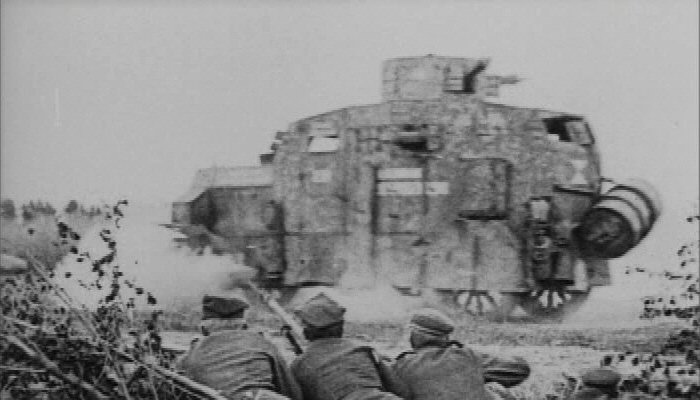 |
|
| Polish Ehrhardt M1917 in a newsreel. | ||
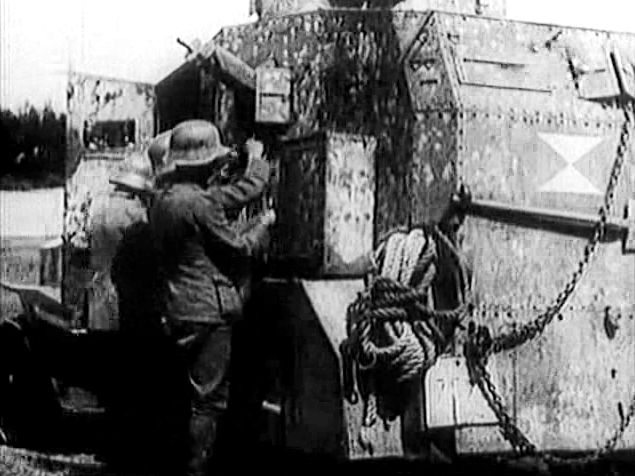 |
 |
|
| Above: Polish soldiers paint "Pułkownik Kazimierz Grudzielski" name. Note presumably German tactical symbol on the rear plate. | ||
| M1915 | M1917 | |
| Crew | 9 | 8 |
| Weight | 9500 kg | 7750 kg |
| Length | 5613 mm | 5300 mm |
| Width | 2007 mm | 2000 mm |
| Height | 3048 mm | 2850 mm |
| Axle span | 3900 mm (?) | 3900 mm[1] |
| Wheels span | 1600 mm (?) | 1600 mm[1] |
| Ground clearance | ? | 350 mm[5] lub 320 mm[1] |
| Max speed | 38 km/h | 60 km/h |
| Range | to 250 km | to 250 km |
Links to Scalemates site
1/76
- M.G.M. (90/21) - Strassenpanzerwagen Erhardt 1917 - old simple resin kit
1/72
- Reviresco (AC-23) - Strassenpanzerkraftwagen Ehrhardt 1917 - very old primitive metal model for wargaming
- Greenminiatures (GM72001-WG) - Ehrhardt E-V/4 1915 - wrong name, in fact Ehrhardt M1917. Primitive resin model for wargaming.
1/35
- White Storm Models (WSM3504) - Ehrhardt M1917 - Polish resin model from 2016
- Copper State Models (CSM35010) - Ehrhardt E-V/4 M.1917 - plastic kit from 2022, high quality, several decals including both Polish versions.
Sources:
Main page – Polish armour – Polish artillery – Steel Panthers – Contact
All photos and pictures remain the property of their owners, unless they are public domain due to age. They are published in non-commercial educational and research purpose.
Text copyright: Michal Derela © 2025.